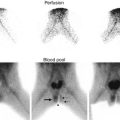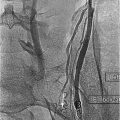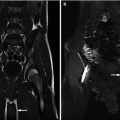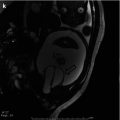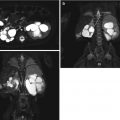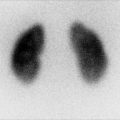Fig. 1.1
The principal organs and vascular and urinogenital systems of a woman, c. 1507 by Leonardo da Vinci
Modern genitourinary tract imaging, however, resulted from the union of two milestone medical specialties. Urology was the first deliberately specified subspecialty in medicine, as evidenced in the oath of Hippocrates. Those who have taken that oath since 450 BC accept responsibility for almost all aspects of healthcare and swear that they “will not cut for stone” but rather should defer that practice to “specialists in that art.” Bladder stones have been a persistent plague for children and adults throughout human history until recent times. Itinerant lithotomists offered surgical treatments throughout most of the ensuing 2.5 millennia after Hippocrates, although left little evidence of their work aside from the oath and subsequent allusions to their existence and practice. Herbalists, midwives, acupuncturists, and other practitioners plied their techniques and trades over those centuries, but in the orthodoxy of Western medicine, other specialties did not emerge until the second half of the nineteenth century.
Even from its primitive start, lithotomy was heavily dependent on technology. One can easily imagine little progress in the technology of knives and other instruments occurred in the time between Hippocrates and the Industrial Revolution. Only as the second half of the nineteenth century proceeded toward the turn of the next century did science and technology produce precision and ingenious instruments such as the lithotrite and optical endoscopes that allowed a new iteration of the lithotomist. Genitourinary surgery, or urology as it came to be called, moved well beyond lithotomy to investigate and treat all sorts of genitourinary pathology with safe and tolerable access to deep interiors of the human body.
Coupled to this new iteration of urology was the discovery of Wilhelm Conrad Roentgen in 1895. His X-ray pictures utilizing the Crookes tube allowed a new level of diagnostic opportunity in the human body. The tipping point was quickly appreciated as in the following year, 1,000 papers were published related to the new modality [2]. That first image of the ring finger of Roentgen’s wife initiated bone visualization, and it was only a short step of imagination to investigate the urinary tract. On July 11, 1896, within a year of Roentgen’s pivotal discovery, Dr. John Macintyre of Glasgow reported the X-ray demonstration of a renal stone [3]. The length of the exposure was 12 min, and a subsequent operative procedure confirmed presence of the stone.
X-ray was not readily adopted as a solution to identifying urinary calculi due to the technical limitations of equipment available at the time. The low output and lack of intensifying screens required exposure times of at least ten minutes, and only large radiopaque calculi could be detected. Variable tube output and scattered radiation weakened image quality [4]. Fenwick in 1897 utilized intraoperative X-ray exposure of a kidney to try to localize a stone but was unsuccessful. In the same year, Tuffier passed a catheter with a metal stylet into the ureter under X-ray to define its course radiologically [5]. This was more of a novelty than any clinical value, although Klose in 1904 demonstrated a duplex ureter by using two styleted catheters [6]. Also in 1904, Keller filled a bladder with air to demonstrate a diverticulum via X-ray [7]. Air and carbon dioxide proved difficult in distinguishing the urinary tract from bowel gas. In 1905 Voelcker and von Lichtenburg, urologically oriented surgeons from Germany and Budapest, reported positive clinical experience with collargol, a colloidal silver material, for cystography via intravesical injection [8]. The director of the General Electric Research Laboratory, William D. Coolidge, invented an X-ray tube with an improved cathode that offered a much more exact and controlled output of the X-ray by 1913 [9]. The Coolidge tube was a major contribution to the developing field of radiology, and its basic design is still used today.
Retrograde Pyelography
Retrograde is a word of distinguished provenance having early been used, if not invented, by Shakespeare. In Hamlet (1599–1602), Claudius tries to dissuade his nephew (and stepson) the prince from returning to school in Wittenberg, saying of that intent:
It is most retrograde to our desire
And we beseech you, bend you to remain
Here in the cheer and comfort of our eye…
In All’s Well that Ends Well (1604–1605), Helena says, “When he was retrograde, I think, rather.” Although a less memorable quote, Helena’s comment still gives a full sense of the term. Astronomy as a field also uses the term, most usually in relation to orbiting planets and their moons. Thus, eight planets in our solar system orbit the sun in one direction called “prograde” (counterclockwise as viewed from the pole star, Polaris), while Venus and Uranus have retrograde orbits.
Medicine did not embrace the term “retrograde” until after 1906 when Voelcker and von Lichtenburg described a happy marriage between Mr. Roentgen’s pictures and urology as they passed a cystoscope into the bladder, catheterized a ureter, and injected a contrast agent so as to “shoot” a retrograde pyelogram and visualize the upper urinary tract [10]. The material injected, 2 % collargol, was a colloidal silver solution they had previously employed for cystography. Stronger solutions, of Argyrol and 5 % silver iodide, caused toxic damage to the ureters and kidney. At some point, the term “retrograde” came into the picture. Other agents such as air, carbon dioxide, and various heavy metal compounds were utilized as agents to delineate the upper urinary tract under X-ray.
Uhle and Pfahler wrote a paper in 1910 that suggested bismuth paste or dense fluids “cast a shadow” [11]. Bismuth, however, was insoluble and its salts were toxic. Thorium nitrate-citrate visualized well but was somewhat irritative and seemed to become toxic after standing. In 1918, Cameron introduced a sodium and potassium iodide contrast material but abandoned the potassium due to toxicity [12]. The resulting 13.5 % sodium iodide became the standard for retrograde pyelography with its minimal toxicity, good visualization, and isotonicity with urine. A variety of other materials including lithium iodide, colloidal thorium dioxide, and Lipiodol did not find enduring places in the investigational armamentarium.
Intravenous Pyelography
Organic iodides proved the most versatile contrast agents for genitourinary imaging. In 1923, Osborne noticed opacification of the urinary tract in patients with syphilis treated with sodium iodide [4]. In the same year, Rowntree used 10 % sodium iodide orally as well as intravenously. Imaging quality was elusive at the contrast volumes that were safe. A young American urologist named Moses Swick introduced a safe and effective form of iodide called uroselectan. Swick had gone to Germany in 1928 to work with Leopold Lichtwitz, a professor of medicine in Hamburg, where he studied an experimental antimicrobial called Selectan-Neutral, a double iodide compound that had been used to treat urinary tract infections. The compound originally was developed in 1923 by Arthur Binz, professor of chemistry in Berlin, in attempts to create agents with minimal toxicity for treating spirochetal and trypanosomal diseases [13]. Given the utility of iodated compounds in urinary tract imaging, Swick attempted to use the agent for human infections as well as for urography but was deterred by the side effects and marginal quality of images. Trying to find a better form of the contrast material and desiring to work with a larger patient population, Swick transferred his investigations to Berlin, where he worked in the urology clinic of Alexander von Lichtenburg. In 1929, he developed a new compound called Uroselectan with a single iodine atom attached to a 5-carbon pyridine ring. This was soluble enough and nontoxic in rabbits, dogs, and finally humans. When injected intravenously, this agent outlined the urinary tract clearly and give birth to the intravenous pyelogram (IVP) [13–15].
Toxic issues of ego and priority cloud the story. Although the creation of Uroselectan seems to have been created by Swick, von Lichtenberg claimed ownership of the innovation. Swick won initial recognition, presenting his work at the Ninth Congress of the German Urologic Society in Munich during which he outlined steps in the discovery of Uroselectan as well as how to perform intravenous urography with the new contrast agent. After Swick’s presentation, von Lichtenburg delivered a paper that listed Swick as coauthor and described their clinical experience with Uroselectan in 84 patients [16].
Swick returned to New York in 1929, where he worked as a urologist at the Mount Sinai Hospital. Mount Sinai’s Chief of Radiology Leopold Jaches presented a sensational paper at the 81st session of the AMA Section on Urology. Leading off the ensuing published discussion of the paper, Leopold Lichtwitz said, “Pyelography by way of excretion is an old desire.” The subsequent debate included Binz, who stated, “Sodium-2-oxo-5-iodo-pyridine-N-acetate, in its present form, was made in 1927, long before Dr. Swick came to Germany. Its selection by me for the purpose of intravenous urography was not due to the suggestions of Dr. Swick but was an answer to clinical principles which had been agreed on by Professor von Lichtenburg and me, before Professor von Lichtenburg’s trip to America last year.” On the other hand, Swick told a different version of the story and stated, “The full data concerning these conferences [with Binz] and other matters here discussed will be presented by me tomorrow before the Section on Urology” [13, 17].
Swick cried foul finding himself barred from the 1930 American Urological Association meeting program even though von Lichtenburg was invited to discuss the principles of intravenous urography. Over the next 35 years, Swick did not receive the recognition he believed was deserved. Victor Marshall, professor of urology at Cornell, led efforts for the Section on Urology of the New York Academy of Medicine to award Swick the distinguished Valentine Medal in 1965. Introductory remarks referred to the three decades of frustration Swick suffered in being overlooked for his contributions to his field, and apologies were subsequently forwarded to Swick from a number of prominent leaders in the AUA [13, 18, 19].
Triiodinated contrast media were developed in the 1950s: acetrizoate sodium (Urokon) in 1955, diatrizoate sodium (Hypaque), methylglucamine salt (Renografin), and iothalamate meglumine (Conray) [4]. These agents became routinely used intravenously, making the IVP the cornerstone of urologic imaging for both adults and children at the time. Radiology departments might perform 15–30 IVPs a day, and in most institutions several radiography rooms were solely dedicated to IVPs [20]. Abdominal compression was routinely implemented to distend the calyces and ureters [21]. If an IVP or retrograde pyelogram suggested presence of a renal parenchymal mass, nephrotomography was commonly performed as a separate study the following day [22]. A scout tomogram was followed by a large dose of contrast material injected rapidly through a large-bore IV with 5 mm thick tomographic sections of the kidney in anteroposterior and oblique views. If the findings implied presence of a simple cyst, with smooth margins and a thin rim, then no further images were obtained. Otherwise, a flush aortogram with selective arteriogram would be performed [20]. Bosniak showed that IVP without tomography often missed renal masses [23].
Percutaneous Nephrostogram and Interventional Radiology
Before cross-sectional imaging became routinely available, percutaneous aspiration with contrast injection of renal cysts was used to characterize renal masses seen on IVP or angiography. Diagnostic percutaneous renal puncture was described by Knut Lindblom in 1952 [24], and percutaneous trocar nephrostomy for hydronephrosis was performed by Willard E. Goodwin in 1955 [25, 26]. It was not until nearly 3 decades later in 1981 that Peter Alken reported percutaneous stone surgery [27].
In the 1970s and 1980s, percutaneous antegrade pyelography became reserved for the study of the hydronephrotic collecting system that could not otherwise be sufficiently evaluated by ultrasound, IVP, or nuclear renography. Percutaneous puncture of the kidney in an infant or child was usually performed with a combination of sedation and local anesthesia. The needle was placed in the dilated collecting system under ultrasonic or fluoroscopic guidance, and the pelvicaliceal system was opacified with injection of contrast followed by fluoroscopic spot films. The antegrade pyelogram was sometimes combined with a pressure-flow study (the Whitaker test) to assess the presence of obstruction within the upper urinary tract [28, 29].
Voiding Cystourethrography
In 1944 upon observing that no reports in the radiology literature described arthrography in children, Brodny and Robins stated, “When sufficient experience has been gained, urethrography will be found as valuable for the study of lower urinary tract disease as pyelography is for the diagnosis of renal pathologic lesions” [30]. They sought to identify the ideal contrast medium to opacify the bladder and urethra and yield sufficient anatomical information. Over the prior four decades, several preparations had been introduced but were imperfect. These included metallic salts, halogen salts, iodized oils, and intravenous urographic media. Solutions of silver salts required such high concentrations for adequate radiopacity that they often resulted in toxicity and local tissue injury. Aqueous suspensions of insoluble barium or bismuth salts provided adequate opacification, but insoluble particles remaining in the bladder required copious irrigation for removal to prevent future calculus formation. Concentrated solutions of sodium and potassium iodides and bromides were irritating, and more dilute solutions did not opacify the urinary tract adequately. Additionally, the poor viscosity of these solutions made them impractical for urethrography. In 1923, Lipiodol was introduced as a nonirritating contrast medium that opacified the lower urinary tract sufficiently. A halogenated oil, iodochloral, later offered similar results. Brodny and Robins performed studies with both media and found two flaws in their use: (1) globules of oil form in the bladder in the presence of urine and make it difficult to outline the base of the bladder and (2) they posed risk of oil embolism in the presence of epithelial lesions [30]. The intravenous contrast media introduced for IVP were adapted for cystourethrography because these substances were considered nonirritating, nontoxic, and well tolerated if absorbed in the bloodstream. They lacked viscosity, however, so attempts were made to thicken these agents with glucose or acacia [31]. Despite this, the agents flowed too rapidly through the urethra to obtain acceptable images.
In 1947 Brodny and Robins introduced rayopake as a superior contrast medium for cystourethrography. It consisted of an organic compound containing iodine diethanolamine to render it soluble in water and a polymeric form of polyvinyl alcohol to increase the viscosity. Rayopake outlined the genitourinary tract clearly, did not form globules when mixed with urine or water, had adequate viscosity for performing urethrography, did not produce emboli, and did not irritate the urethral epithelium [30].
Despite safe, well-tolerated contrast solutions, evaluation of the lower urinary tract by means of VCUG took several decades for acceptance. After promoting their choice of contrast agent for cystourethrography, Brodny and Robins emphasized the utility of both retrograde and voiding cystourethrography in evaluating boys with suspected urologic disorders. Until they published their series of pediatric cystourethrographic studies in 1948, the merits of this study in children had not been sufficiently recognized [32]. A typical investigation of urinary tract pathology in children mid-century included IVP followed by endoscopy under general anesthesia. Because most parents and pediatricians did not wish to subject a child to a general anesthetic if the IVP was considered normal, IVP became the blanket test for evaluating the entire urinary tract. Direct radiologic investigation of the lower urinary tract was avoided for a number of reasons: (1) the difficulty of performing a voiding cystourethrogram on children, (2) fear of radiation exposure to the gonads, and (3) lack of appreciation for the value of a VCUG among clinicians at the time [33]. Radionuclide cystography was introduced in 1959 [34] and was considered by some superior to VCUG because it allowed quantitation of parameters affecting bladder function and could more adequately evaluate the filling and emptying of the bladder [35].
In the early to mid-1960s, VCUG became more accepted as a major diagnostic tool in pediatric uroradiology. Today VCUG is the principal examination used for the study of the bladder and urethra in children and considered the standard for detecting vesicoureteral reflux. The retrograde urethrogram is the primary urographic study for demonstrating the details of abnormalities in the male urethra below the level of the sphincter.
Ultrasonography
Black-background real-time ultrasound became standard in the late 1970s. Digital scan converters allowed for obtaining images quickly, and soon ultrasonography became the gold standard for differentiating solid from cystic renal lesions, making nephrotomography and arteriography second line in the evaluation of renal masses [20, 36]. Ultrasonography changed the approach to the imaging of the urinary tract in the child, leading to decreased utilization of IVPs by the late 1970s [37]. Whereas IVP was once the first-line test for the exploration of pediatric urological diseases, ultrasound soon became the preferred form of imaging. The reduced risk of ionizing radiation, contrast reactions, and iatrogenic complications made ultrasound ideal for evaluating newborns, infants, and children as well as the fetal urinary tract in utero [38]. In the early 1980s, the lack of all risk was not completely proven, so ultrasound was still used in moderation, especially in pregnancy [39, 40].
With improvement in ultrasonographic imaging over the last 30 years, more facile detection of urologic abnormalities in the antenatal period has changed the practice of pediatric urology. Detection of clinically significant antenatal hydronephrosis helps the pediatric urologist plan treatment, if indicated, in the neonatal period as well as determine whether fetal intervention is warranted. Antenatally detected urologic diagnoses may lead to a prenatal visit between parents and the pediatric urologist, helping to establish rapport and provide reassurance prior to delivery [41, 42].
Ultrasonography has also afforded us an accessible, inexpensive, and safe way to follow young patients after delivery and understand the natural history of urologic problems. For example, before antenatal ultrasound, patients with primary obstructed megaureter typically did not present until later in life with symptoms of pyelonephritis. Of those with megaureter now detected antenatally, we know that approximately 80 % will have spontaneous resolution of hydronephrosis over time and not require intervention, but those that persist or progress can be repaired [43]. Antenatal detection of hydronephrosis on ultrasound has also resulted in the early elective detection of vesicoureteral reflux with VCUG. While such information is debated by some authorities, we believe that early recognition of vesicoureteral reflux can preempt reflux nephropathy in many children [44].
Stay updated, free articles. Join our Telegram channel

Full access? Get Clinical Tree


